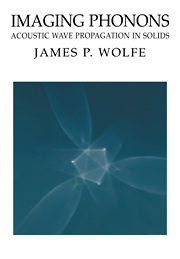Book contents
- Frontmatter
- Contents
- Preface
- Prologue – Anisotropic heat flow in crystals
- 1 Ballistic heat pulses and phonon imaging – A first look
- 2 Phonon focusing
- 3 Generation and detection of phonons – Experimental aspects
- 4 Focusing in cubic crystals
- 5 Acoustic symmetry and piezoelectricity
- 6 Lattice dynamics
- 7 Imaging of dispersive phonons
- 8 Phonon dynamics
- 9 Bulk scattering of phonons – Experiments
- 10 Quasidiffusion and the phonon source
- 11 Phonon scattering at interfaces
- 12 Refraction and reflection at solid/solid interfaces – Experiment
- 13 Imaging ultrasound in solids
- 14 Imaging surface acoustic waves
- 15 Interactions of ballistic phonons with electrons
- Appendix I Algebraic solution to the wave equation
- Appendix II Abbreviated tensor notation and group velocity
- Appendix III Survey of phonon focusing in cubic crystals
- Index
10 - Quasidiffusion and the phonon source
Published online by Cambridge University Press: 24 March 2010
- Frontmatter
- Contents
- Preface
- Prologue – Anisotropic heat flow in crystals
- 1 Ballistic heat pulses and phonon imaging – A first look
- 2 Phonon focusing
- 3 Generation and detection of phonons – Experimental aspects
- 4 Focusing in cubic crystals
- 5 Acoustic symmetry and piezoelectricity
- 6 Lattice dynamics
- 7 Imaging of dispersive phonons
- 8 Phonon dynamics
- 9 Bulk scattering of phonons – Experiments
- 10 Quasidiffusion and the phonon source
- 11 Phonon scattering at interfaces
- 12 Refraction and reflection at solid/solid interfaces – Experiment
- 13 Imaging ultrasound in solids
- 14 Imaging surface acoustic waves
- 15 Interactions of ballistic phonons with electrons
- Appendix I Algebraic solution to the wave equation
- Appendix II Abbreviated tensor notation and group velocity
- Appendix III Survey of phonon focusing in cubic crystals
- Index
Summary
This chapter attempts to characterize the acoustic phonons generated when a semiconductor crystal is excited by light. These phonons are a byproduct of the energy relaxation of photoexcited carriers. The problem naturally divides into two parts: (a) the distributions (in space, time, and frequency) of acoustic phonons emanating from the excitation region, i.e., the phonon source, and (b) the subsequent propagation and decay (downconversion) of acoustic phonons in the bulk of the sample. Because elastic scattering from mass defects is highly dependent on frequency, the instantaneous diffusion constant increases with time as phonons downconvert – a process commonly referred to as quasidiffusion. In principle, low-frequency phonon sources produce ballistically propagating phonons and high-frequency sources lead to quasidiffusion.
Previous chapters have dealt mainly with heat pulses generated by optical excitation of a metal film that was deposited on the nonmetallic crystal of interest. Nonequilibrium phonons are again produced by the relaxation of the carriers excited by the light. In the metal, however, there is a high density of free carriers (1022–1023 cm−3), and the interactions among carriers and between carriers and phonons tend to establish a single temperature. In that case, the phonons radiated from the metal film into the crystal have an approximately Planckian energy distribution, and the subsequent propagation in the crystal can be modeled by anharmonic decay, elastic scattering, and ballistic propagation (with frequency dispersion).
- Type
- Chapter
- Information
- Imaging PhononsAcoustic Wave Propagation in Solids, pp. 244 - 274Publisher: Cambridge University PressPrint publication year: 1998



